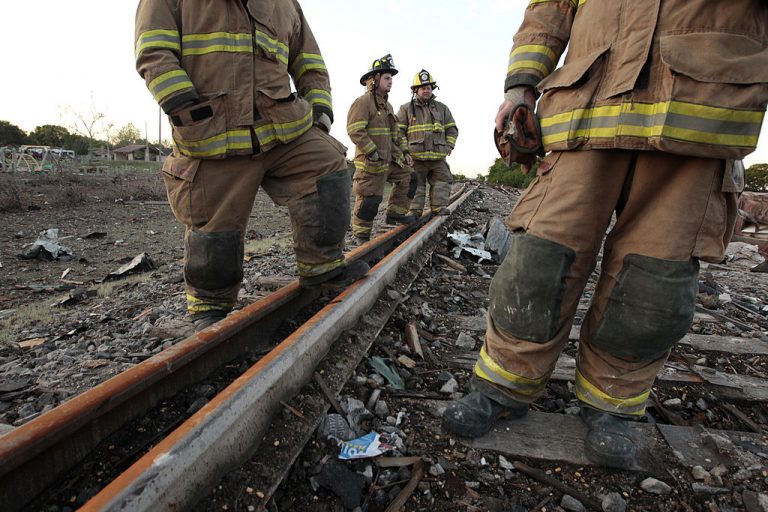A community rallied together this week to avoid potential disaster as a burgeoning fire reported Jan. 31 at the Winston Weaver Co. fertilizer plant in Winston-Salem, North Carolina approached a cache of 600 tons of ammonium nitrate, a highly explosive chemical used in fertilizers.
The 6,500 residents within a one-mile radius of the plant were ordered to evacuate, with first responders knocking door to door, urging people to leave.
According to a statement shared by the Winston-Salem Police Department on Twitter, Fire Chief Trey Mayo warned residents to be proactive about safety and not to “wait for something to happen.”
Mayo tweeted, ”Something has happened. Now is the time to get out.”
At a subsequent press conference, Mayo clarified the urgency, “At the beginning of this incident there was enough ammonium nitrate on hand for this to be one of the worst explosions in U.S. history.”
Success
You are now signed up for our newsletter
Success
Check your email to complete sign up
Ammonium nitrate exposed to high temperatures can create toxic and explosive nitrogen oxide and ammonia. According to CBS News, this chemical caused both the deadly port explosion in Beirut, a fatal 2018 blast at a Texas fertilizer plant, and was used in the Oklahoma City bombing.
RELATED ARTICLES:
- Ordinary North Koreans Steal Feces for Fertilizer While Officials Import Chinese New Year Luxuries
- How Fertilizer Shortages Are Impacting European Food Prices
Fortunately, conditions the first night of the blaze allowed the fire to remain relatively static and welcome rains began as a critical 36-hour window progressed. However, with the rains, smoke became an issue as the precipitation pushed chemical-laden smoke further towards ground level.
Winston-Salem Fire Battalion Chief Patrick Grubbs explained that the fire team was playing a waiting game. Initially they had fought the blaze proactively, but a danger loomed as the fire approached a train car that appeared to have held a risk of explosion.
He said that after that, he pulled the team back and allowed the fire to burn itself out, as the risk of going in was too high when weighed against the alternative of letting the flames run their course. At the time of his statement, the fire was using up its fuel and had stopped spreading.
Grubbs recommended precautions to avoid inhalation and warned those with preexisting lung conditions to take notice.
Locals uncertain
The police department asked evacuating residents to prepare to be gone for at least 48 hours and emergency shelters were opened, including in a library of Wake Forest University, which had also been evacuated. By Friday, shelters were no longer operational and many residents began returning to their homes.
According to an emergency report line operator in the local area, residents within 0.8 miles from the facility might still be advised to stay away, although this was not known. The operator confirmed that the major issue at this time seems to be the need for residents to avoid inhaling the smoke, which was caused by the initial blaze and its smoldering remains.
Thursday evening, according to a tweet by the Winston Salem Fire Department, the evacuation order was reduced to 660 feet from the fertilizer plant.
Winston-Salem’s home county of Forsyth could not be immediately reached for comment as of close of business on Friday. It was not confirmed whether a water outage reported by local municipal services in a neighboring zip code was related to diversion of water needed to fight the fire.
With Forsyth County offices not reopening until Monday, the local police and fire department Twitter accounts remain key sources of information for Winston-Salem residents. Images on the FD’s Twitter account released in the late afternoon on Friday showed visibly poor air quality at the scene, including some billows of smoke, but no active fire.
Photos released three hours before showed a thick haze of smoke obscuring vision on the ground.
Second significant chemical fire in the eastern US in two weeks
The Winston Weaver Co. blaze is the second significant chemical fire in the eastern U.S. in two weeks.
A huge 11-alarm chemical plant fire occurred on Jan. 14 in Passaic, New Jersey, but was fortunately contained just inside of 48 hours as hundreds of firefighters from multiple fire companies worked overnight to keep the blaze from reaching the main chemical plant at Qualco. Concerns of explosions led to an evacuation within a limited area.
In both instances, evacuations were made harder on the population by the winter weather. Although the weather also hampered the spread of these fires — frozen precipitation on the ground prevented dryer conditions in New Jersey and rains brought a turning point in fire control for residents.
















